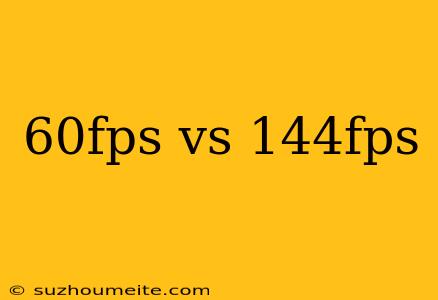FPS Wars: 60fps vs 144fps
In the world of gaming and video production, frame rate has become a crucial aspect of the viewer experience. Two of the most popular frame rates currently dominating the market are 60fps and 144fps. But what's the difference between them, and which one is better?
What is Frame Rate?
Before diving into the comparison, it's essential to understand what frame rate is. Frame rate, measured in frames per second (fps), is the number of images displayed on a screen in one second. The higher the frame rate, the smoother the motion and the more realistic the experience.
60fps: The Standard
60fps has been the standard for most gaming and video applications for quite some time. It's a sweet spot that offers a good balance between performance and visual quality. With 60fps, you get:
Pros:
- Smooth motion: 60fps provides a smooth and fluid motion, making it suitable for most types of content, including games, movies, and sports.
- Wide compatibility: 60fps is supported by most modern devices, including smartphones, TVs, and computers.
- Efficient performance: 60fps is less demanding on hardware, making it a more efficient choice for devices with limited processing power.
Cons:
- Limited detail: 60fps may not be able to capture fast-paced action or high-speed movements as smoothly as higher frame rates.
144fps: The New Standard?
In recent years, 144fps has emerged as a new benchmark for high-end gaming and video production. With 144fps, you get:
Pros:
- Ultra-smooth motion: 144fps offers an even smoother and more realistic experience, particularly in fast-paced games or high-speed content.
- Enhanced detail: 144fps can capture more detail in fast-paced action, making it ideal for fast-paced games, sports, and action movies.
- Future-proofing: As hardware technology advances, 144fps will become more accessible and widespread.
Cons:
- High system requirements: 144fps requires powerful hardware to maintain a consistent frame rate, making it less accessible to devices with limited processing power.
- Limited compatibility: 144fps is not yet widely supported by all devices, and may require specific hardware or software configurations.
Conclusion
So, which one is better? The answer depends on your specific needs and preferences. If you're looking for a balanced experience with smooth motion and wide compatibility, 60fps might be the way to go. However, if you're looking for an ultra-realistic experience with enhanced detail and smoother motion, 144fps is the better choice.
As technology continues to advance, we can expect to see even higher frame rates become more accessible and widespread. But for now, 60fps and 144fps are the two most dominant forces in the world of frame rates.
